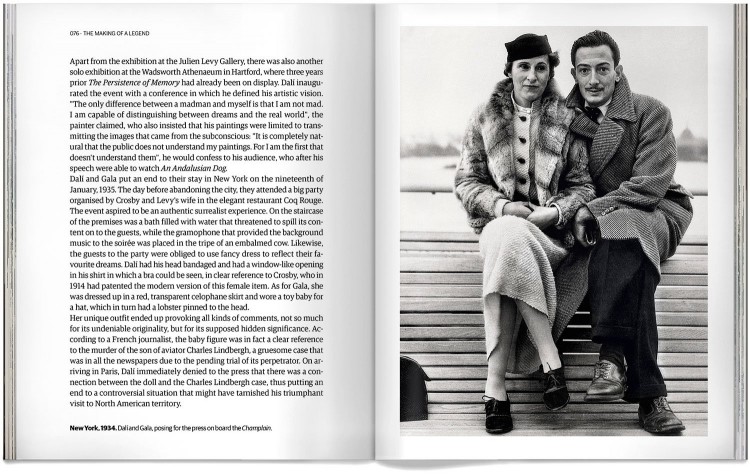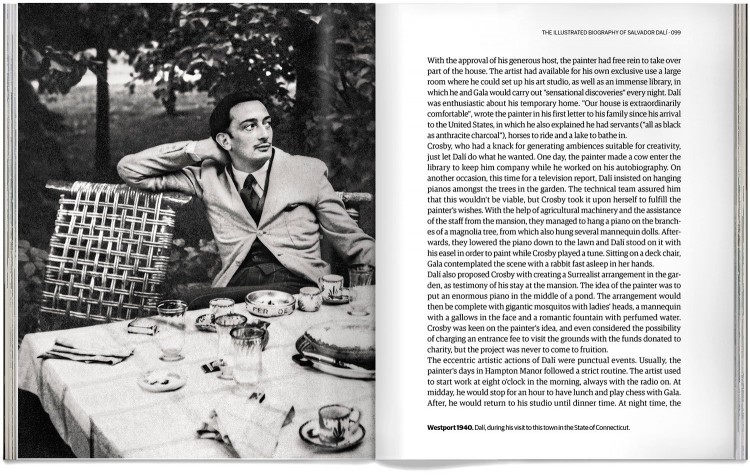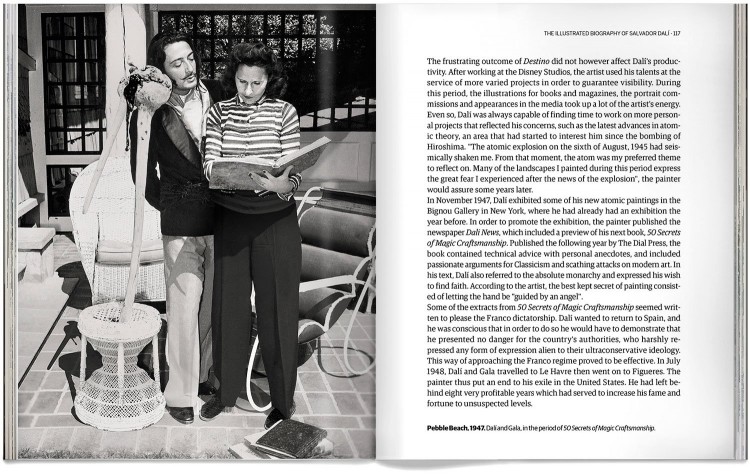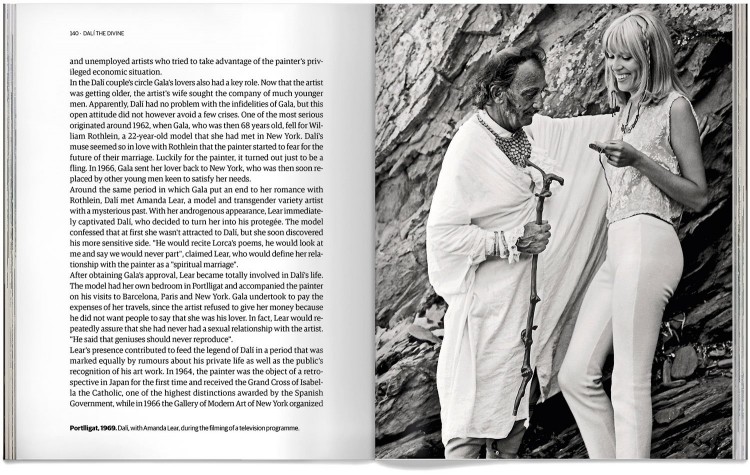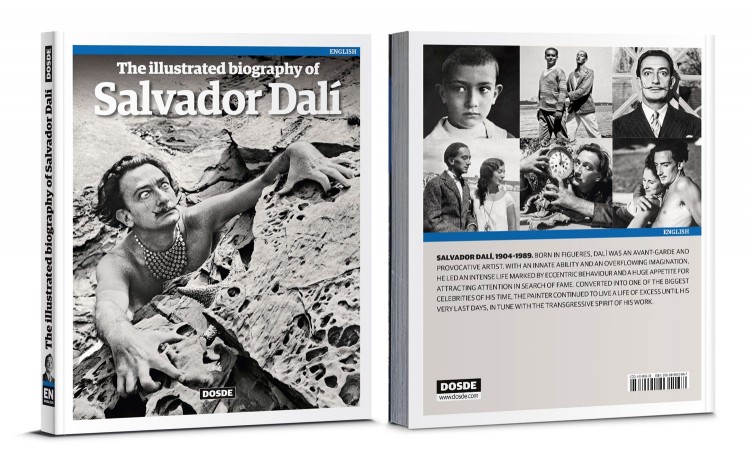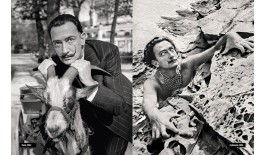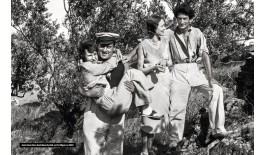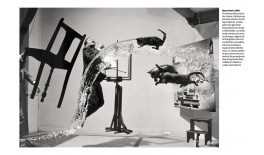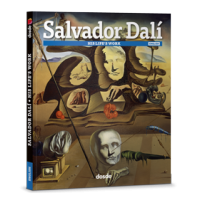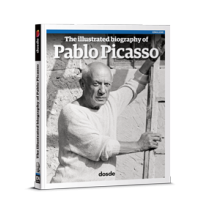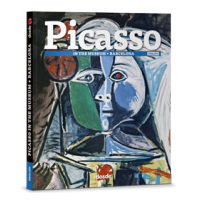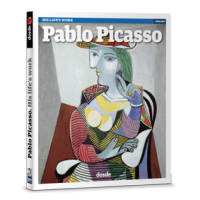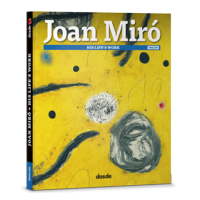Illustrated biography of Salvador Dalí
RETURN
About the book Biography of Dalí
This biography on Salvador Dalí covers the career of one of the great artistic icons of all time. The work unveils the most significant episodes in Dalí's fascinating life, while it provides the keys to understand the thought-provoking, creative universe of this genius of the art world.
Divided into nine chapters, this biography on Dalí, published by Dosde, follows the chronological order of the artist's life from his childhood to his final days. The book goes into detail about the most unknown aspects of his life and delves into the relationship of the painter with the people that marked his life and his career, such as Gala, who would become his muse and his wife.
The book is an illustrated biography of Salvador Dalí, and therefore boasts more than 150 photographs of Dalí, his environment and his relationship. All this graphical material, along with the comprehensive information of the book allows the reader to discover who is Salvador Dalí, an avoidable reference of the 20th century, whose legacy has marked the work of various generations of artists.
Divided into nine chapters, this biography on Dalí, published by Dosde, follows the chronological order of the artist's life from his childhood to his final days. The book goes into detail about the most unknown aspects of his life and delves into the relationship of the painter with the people that marked his life and his career, such as Gala, who would become his muse and his wife.
The book is an illustrated biography of Salvador Dalí, and therefore boasts more than 150 photographs of Dalí, his environment and his relationship. All this graphical material, along with the comprehensive information of the book allows the reader to discover who is Salvador Dalí, an avoidable reference of the 20th century, whose legacy has marked the work of various generations of artists.
Visual Edition
Illustrated biography of Salvador Dalí
It includes exclusive digital content
Made with environmentally friendly paper
Official licensed product
"Premio Clap" Best Design category
About the book Biography of Dalí
This biography on Salvador Dalí covers the career of one of the great artistic icons of all time. The work unveils the most significant episodes in Dalí's fascinating life, while it provides the keys to understand the thought-provoking, creative universe of this genius of the art world.
Divided into nine chapters, this biography on Dalí, published by Dosde, follows the chronological order of the artist's life from his childhood to his final days. The book goes into detail about the most unknown aspects of his life and delves into the relationship of the painter with the people that marked his life and his career, such as Gala, who would become his muse and his wife.
The book is an illustrated biography of Salvador Dalí, and therefore boasts more than 150 photographs of Dalí, his environment and his relationship. All this graphical material, along with the comprehensive information of the book allows the reader to discover who is Salvador Dalí, an avoidable reference of the 20th century, whose legacy has marked the work of various generations of artists.
Divided into nine chapters, this biography on Dalí, published by Dosde, follows the chronological order of the artist's life from his childhood to his final days. The book goes into detail about the most unknown aspects of his life and delves into the relationship of the painter with the people that marked his life and his career, such as Gala, who would become his muse and his wife.
The book is an illustrated biography of Salvador Dalí, and therefore boasts more than 150 photographs of Dalí, his environment and his relationship. All this graphical material, along with the comprehensive information of the book allows the reader to discover who is Salvador Dalí, an avoidable reference of the 20th century, whose legacy has marked the work of various generations of artists.
Videos Illustrated biography of Salvador Dalí
No reviews yet.
Additional Information
- Additional Information
- Subtitle: No
- Weight (g): 350
- Binding: Paperback with flaps
- Size (cm): 16,5 x 20,5
- Author: Dosde
- Pages: 0
- Edition: Visual Edition
Salvador Dalí biography
The artist's early works are marked by the relationship with his family and his contact with the landscapes of L'Empordà, the Catalan region where Salvador Dalí was born. In 1922, the painter begins his Fine Art Studies in Madrid and becomes involved in the avant-garde, where he comes into contact with characters such as Lorca and Buñuel.
Seven years later, Dalí meets Gala, who becomes his muse and partner, and embarks on his surrealist period. During this time, Dalí alternates the stays in his home country with long periods in Paris, the capital of the artistic avant-garde, and with his first trips to America, where he receives star treatment.
The Second World War forces the artist to live in golden exile in the United States in the company of Gala, his inseparable companion. In 1948, Dalí goes back home to Spain again and gives a new impetus to his career by incorporating elements of religious and scientific inspiration into his art.
During his mature period, the painter immerses himself in the development of his own legend in order to maintain the public's attention and his prominent role in the art world. During the final years, Dalí alternates artistic elements and the building of his Theatre-Museum by participating in important tributes to celebrate his career. Dalí dies in Figueres on the 23rd of January 1989.
The artist, who was eighty-four, died from a a cardiorespiratory arrest while listening to one of his favourite operas, Tristan and Isolde. His body was embalmed, just as the painter had requested, and two days later it was buried in a multitudinous ceremony below the dome of the Theatre-Museum.
Thus, Dalí, a character who had distinguished himself by making his life an artistic representation, was united forever to his last great work.
Driven by a curiosity that seemed to have no limits, accompanied by a great capacity for work, the Surrealist genius explored throughout his long career a wide variety of disciplines, ranging from painting to cinema as well as the world of literature, fashion and theatre, providing revolutionary contributions to all fields that allowed him to become one of the most well-known and popular artists of his time.
The international fame achieved by Dalí was not only thanks to his singular artistic vision and his tireless promotional work, but also due to his fascinating life, which gave rise to all sorts of rumours, many of which were spread by the actual artist himself.
Even at this present time, the biography of Dalí still continues to generate much controversy and debate. In fact, new books on Dalí continue to be published devoted to the analysis of his personnage.
One of the most well known Salvador Dalí quotes is: "The difference between false and real memories is the same as for jewels: the fake ones always look more real, more brilliant". The artist never hesitated to distort his own past, manipulating it in order to suit his own interests. For this reason Dalí appears as a multifaceted character, brimming with enigmas and contradictions.
His childhood holds some of the main keys to his mysterious personality as it was during this period that his first obsessions and traumas evolved, some of which would accompany the artist for the rest of his days.
In his youth Dalí's evolution was determined by the development of new friendships and, above all, by the arrival of Gala, his lover and muse, whose influence was intrinsically linked to the subsequent trajectory of the artist. During his mature period, Dalí continued to undergo profound changes at a personal level, largely due to his need to adapt to historical circumstances as complex as the actual painter himself.
The painter drew on many of his own life experiences and included some of his most private thoughts in his works, incorporating a large variety of symbolic images that, with the passing of time, have gone beyond their original meaning in order to become true emblems of popular culture.
A large part of Dalí's creative vision stems from the theories of Sigmund Freud, the founding father of pyschoanalysis. Published in Spain for the first time in 1924, The Interpretation of Dreams, one of the most influential works of the Viennese doctor, was an absolute revelation for Dalí.
"It seemed to be one of the major discoveries of my life", the artist said, who after reading the book became obsessed with the workings of the subconcious. The Surrealist Manifesto, which was influenced by Freud's ideas, also left a deep impression on the painter.
Published in October 1924, the document with which the French poet André Breton founded the fundaments of Surrealism proposed a revolutionary work method: in order to operate with total freedom, artists needed to ignore the filters imposed by reason and be guided exclusively by primary impulses, ignoring any aesthetic and moral convention.
Throughout his biography, Dalí spent a lot of time and energy on building up his own legend. Aware of the new role that artists could play in the consumer society, Dalí planned in great detail each one of his public appearances, converting them into creative events packed with imagination that would attract the attention of a media with an evergrowing appetite.
The painter used all resources within reach to project an image of an eccentric and groundbreaking artist which enabled him to obtain international fame and recognition. This need for protagonism was rebuked by determined cultural sectors, but Dalí always showed indifference to any criticism.
The surrealist celebrity never gave up on following his own path, even at the risk of damaging his own reputation.
The biography of Dalí is closely linked to Gala. Ten years older than Dalí, Gala was actually called Elena Ivanovna Diakonova and was originally from the Russian city of Kazán, although she spent her childhood in Moscow, where, after completing her studies with excellent qualifications, started working as a private teacher.
Her professional career was interrupted in 1912, when, due to tuberculosis, she was admitted to the Swiss sanatorium of Clavadel. It was there that she met Éluard, whom she would marry in 1917.
Through her husband, Gala came into contact with the Surrealists. Her immersion in the collective led by Breton was total. Gala actively participated in the meetings of the group and ended up converting into the muse of figures such as the German painter Max Ernst, with whom she had a long romance with the consent of Éluard, who, just like her, was a firm supporter of open relationships.
Provided with a strong personality and totally liberated in the world of sex, Gala was the absolute opposite to the introverted Dalí, and probably for this same reason the painter was immediately attracted to her.
According to Dalí, the first day they met eachother Gala confessed to him that she disliked his elegant appearance, for which the following day the artist decided to radically change his look in order to get her attention.
Instead of using his usual aftershave, he applied a paste to his body made from lavender oil, fishtail and goat manure. Likewise, he cut his shirt, stained his armpits with blood and stuck a red geranium behind his ear.
Seven years later, Dalí meets Gala, who becomes his muse and partner, and embarks on his surrealist period. During this time, Dalí alternates the stays in his home country with long periods in Paris, the capital of the artistic avant-garde, and with his first trips to America, where he receives star treatment.
The Second World War forces the artist to live in golden exile in the United States in the company of Gala, his inseparable companion. In 1948, Dalí goes back home to Spain again and gives a new impetus to his career by incorporating elements of religious and scientific inspiration into his art.
During his mature period, the painter immerses himself in the development of his own legend in order to maintain the public's attention and his prominent role in the art world. During the final years, Dalí alternates artistic elements and the building of his Theatre-Museum by participating in important tributes to celebrate his career. Dalí dies in Figueres on the 23rd of January 1989.
The artist, who was eighty-four, died from a a cardiorespiratory arrest while listening to one of his favourite operas, Tristan and Isolde. His body was embalmed, just as the painter had requested, and two days later it was buried in a multitudinous ceremony below the dome of the Theatre-Museum.
Thus, Dalí, a character who had distinguished himself by making his life an artistic representation, was united forever to his last great work.
Who is Dalí?
Provided with indisputable artistic talent and boundless imagination, Salvador Dalí is considered to be one of the most multi-talented creators of the twentieth century.Driven by a curiosity that seemed to have no limits, accompanied by a great capacity for work, the Surrealist genius explored throughout his long career a wide variety of disciplines, ranging from painting to cinema as well as the world of literature, fashion and theatre, providing revolutionary contributions to all fields that allowed him to become one of the most well-known and popular artists of his time.
The international fame achieved by Dalí was not only thanks to his singular artistic vision and his tireless promotional work, but also due to his fascinating life, which gave rise to all sorts of rumours, many of which were spread by the actual artist himself.
Even at this present time, the biography of Dalí still continues to generate much controversy and debate. In fact, new books on Dalí continue to be published devoted to the analysis of his personnage.
A multifaceted character
One of the most well known Salvador Dalí quotes is: "The difference between false and real memories is the same as for jewels: the fake ones always look more real, more brilliant". The artist never hesitated to distort his own past, manipulating it in order to suit his own interests. For this reason Dalí appears as a multifaceted character, brimming with enigmas and contradictions.His childhood holds some of the main keys to his mysterious personality as it was during this period that his first obsessions and traumas evolved, some of which would accompany the artist for the rest of his days.
In his youth Dalí's evolution was determined by the development of new friendships and, above all, by the arrival of Gala, his lover and muse, whose influence was intrinsically linked to the subsequent trajectory of the artist. During his mature period, Dalí continued to undergo profound changes at a personal level, largely due to his need to adapt to historical circumstances as complex as the actual painter himself.
The icon of Surrealism
Precursor of the transformation of art into spectacle, Salvador Dalí's life was rather like one great surrealist work, blurring the boundaries between reality and imagination. Salvador Dalí's creative universe was closely linked to his own personal development.The painter drew on many of his own life experiences and included some of his most private thoughts in his works, incorporating a large variety of symbolic images that, with the passing of time, have gone beyond their original meaning in order to become true emblems of popular culture.
A large part of Dalí's creative vision stems from the theories of Sigmund Freud, the founding father of pyschoanalysis. Published in Spain for the first time in 1924, The Interpretation of Dreams, one of the most influential works of the Viennese doctor, was an absolute revelation for Dalí.
"It seemed to be one of the major discoveries of my life", the artist said, who after reading the book became obsessed with the workings of the subconcious. The Surrealist Manifesto, which was influenced by Freud's ideas, also left a deep impression on the painter.
Published in October 1924, the document with which the French poet André Breton founded the fundaments of Surrealism proposed a revolutionary work method: in order to operate with total freedom, artists needed to ignore the filters imposed by reason and be guided exclusively by primary impulses, ignoring any aesthetic and moral convention.
A master of provocation
Throughout his biography, Dalí spent a lot of time and energy on building up his own legend. Aware of the new role that artists could play in the consumer society, Dalí planned in great detail each one of his public appearances, converting them into creative events packed with imagination that would attract the attention of a media with an evergrowing appetite.The painter used all resources within reach to project an image of an eccentric and groundbreaking artist which enabled him to obtain international fame and recognition. This need for protagonism was rebuked by determined cultural sectors, but Dalí always showed indifference to any criticism.
The surrealist celebrity never gave up on following his own path, even at the risk of damaging his own reputation.
Gala, Dalí's wife
The biography of Dalí is closely linked to Gala. Ten years older than Dalí, Gala was actually called Elena Ivanovna Diakonova and was originally from the Russian city of Kazán, although she spent her childhood in Moscow, where, after completing her studies with excellent qualifications, started working as a private teacher.Her professional career was interrupted in 1912, when, due to tuberculosis, she was admitted to the Swiss sanatorium of Clavadel. It was there that she met Éluard, whom she would marry in 1917.
Through her husband, Gala came into contact with the Surrealists. Her immersion in the collective led by Breton was total. Gala actively participated in the meetings of the group and ended up converting into the muse of figures such as the German painter Max Ernst, with whom she had a long romance with the consent of Éluard, who, just like her, was a firm supporter of open relationships.
Provided with a strong personality and totally liberated in the world of sex, Gala was the absolute opposite to the introverted Dalí, and probably for this same reason the painter was immediately attracted to her.
According to Dalí, the first day they met eachother Gala confessed to him that she disliked his elegant appearance, for which the following day the artist decided to radically change his look in order to get her attention.
Instead of using his usual aftershave, he applied a paste to his body made from lavender oil, fishtail and goat manure. Likewise, he cut his shirt, stained his armpits with blood and stuck a red geranium behind his ear.

